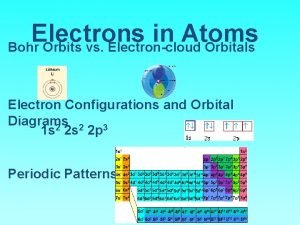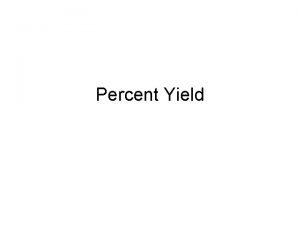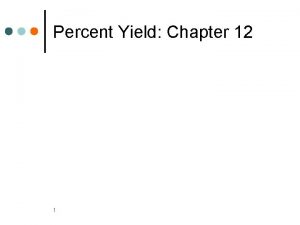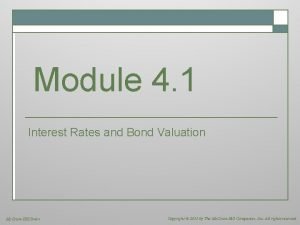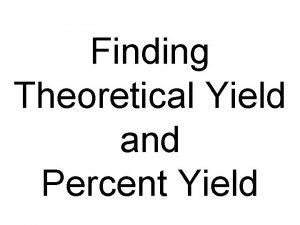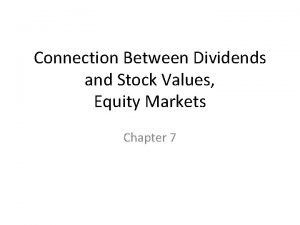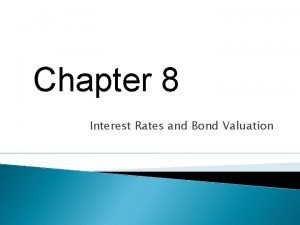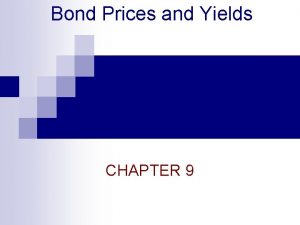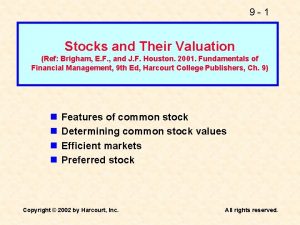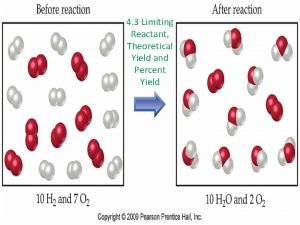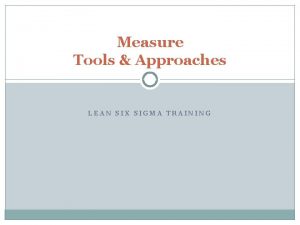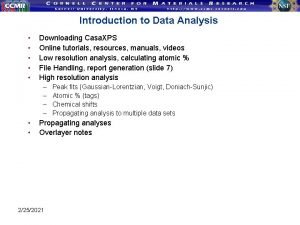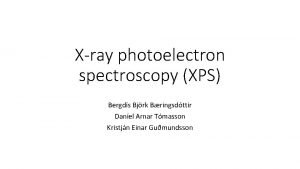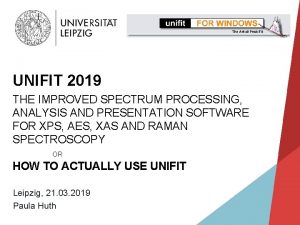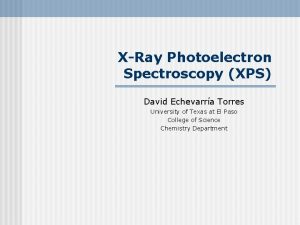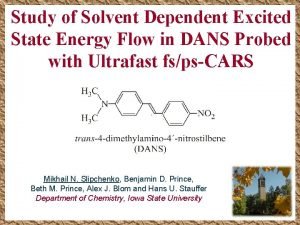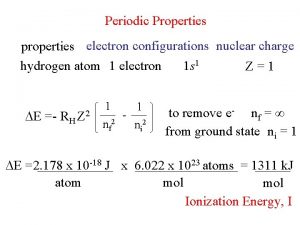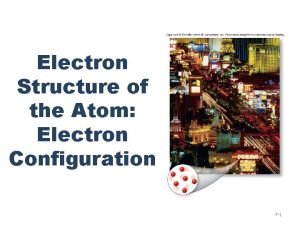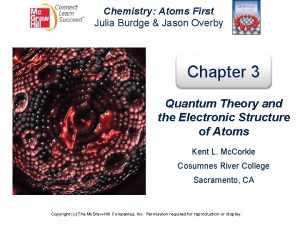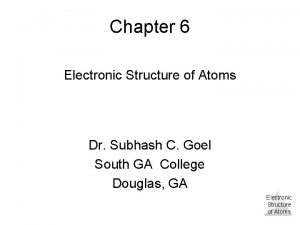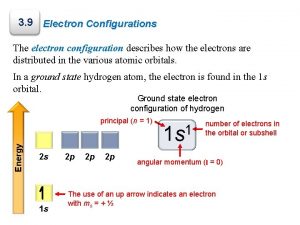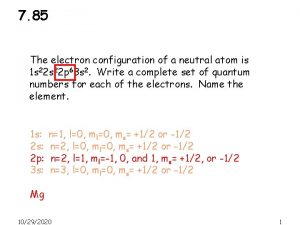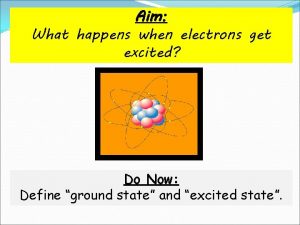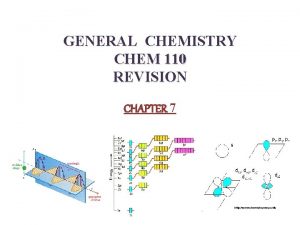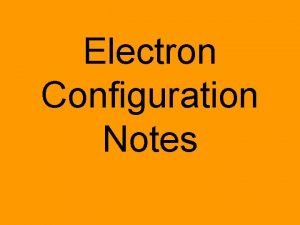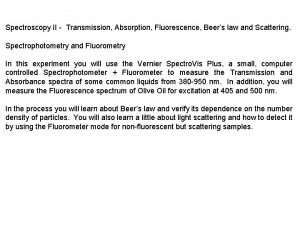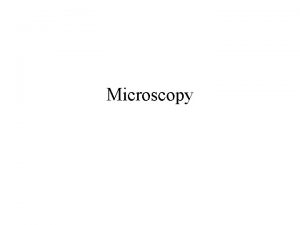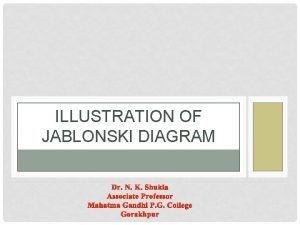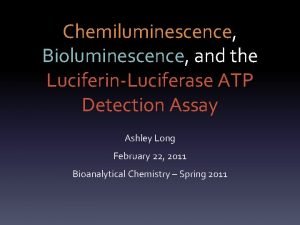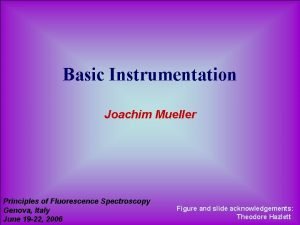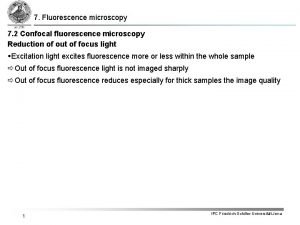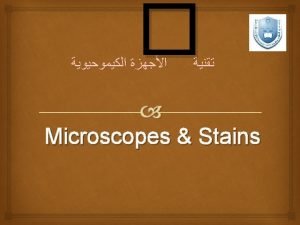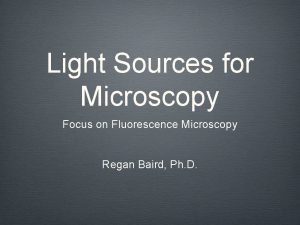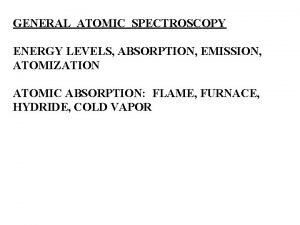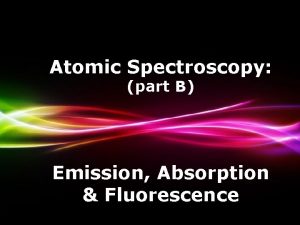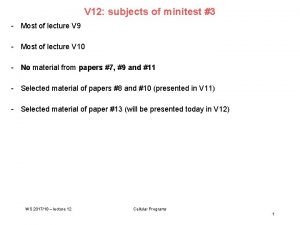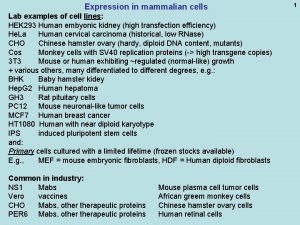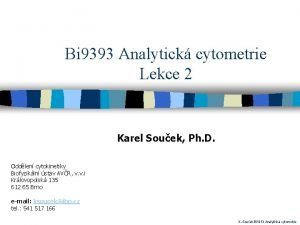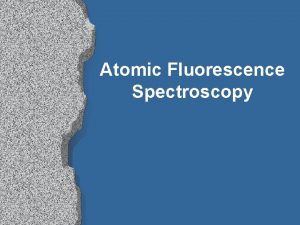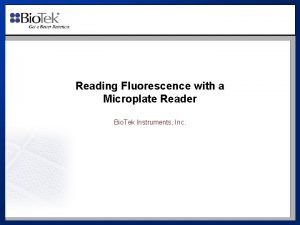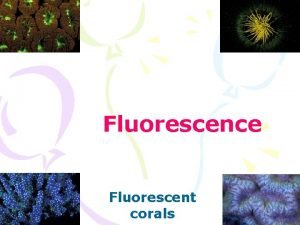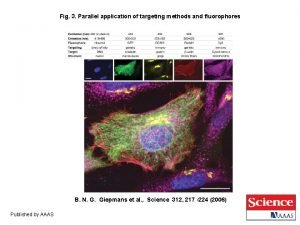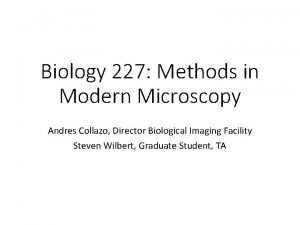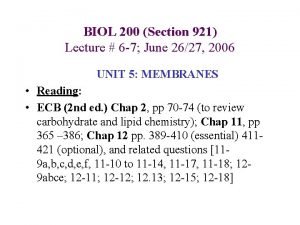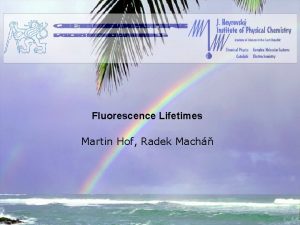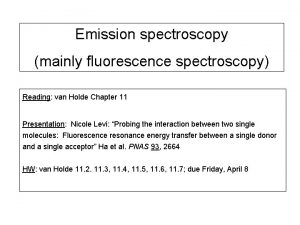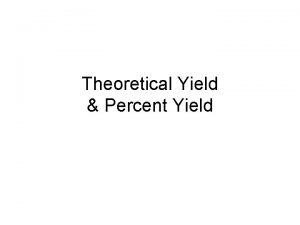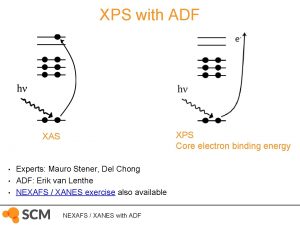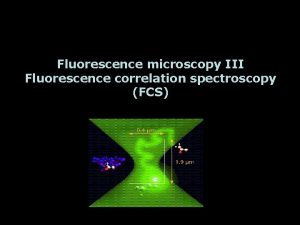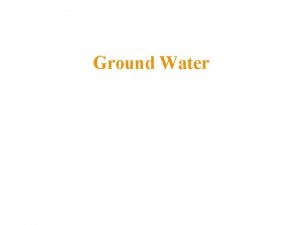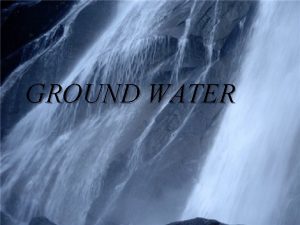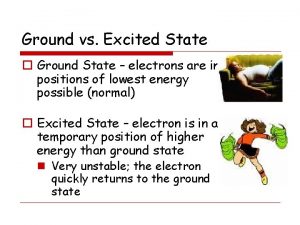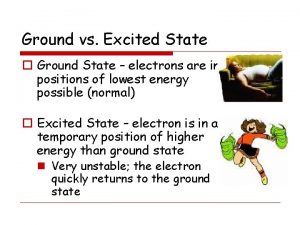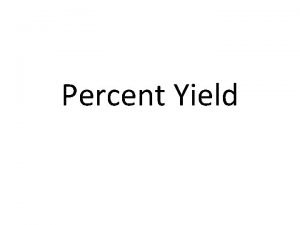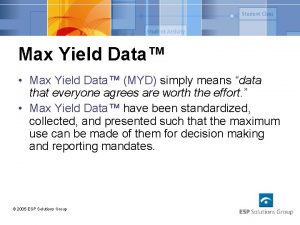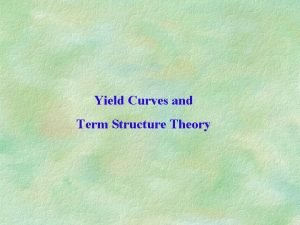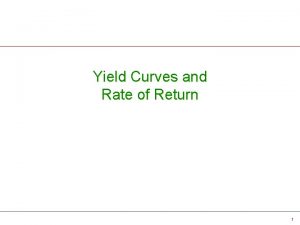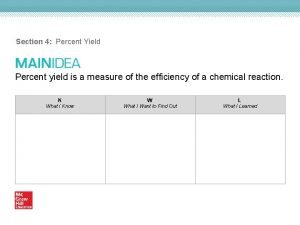Fluorescence Yield detection XPS Ground state analysis Fluorescence















































![CTM 4 DOC 48 [Delgado et al. J. Synchrot. Rad 23, 1264 (2016)] 48 CTM 4 DOC 48 [Delgado et al. J. Synchrot. Rad 23, 1264 (2016)] 48](https://slidetodoc.com/presentation_image_h2/7a76a7e78bb3153d31ed4811a94ad9fe/image-48.jpg)



- Slides: 51

• Fluorescence Yield detection • XPS • Ground state analysis

Fluorescence Yield detection • • FY (1. dilute limit) FY (2. state dependent decay) FY (3. inverse PFY) FY (4. dips and peaks)

Fluorescence Yield detection •

Fluorescence Yield detection •

Fluorescence Yield detection •

FY detection of dilute sample

Fluorescence Yield FY detection of non-dilute sample “saturation & self-absorption” De-saturation software (μ(ω) based on CRXO)

XAS of radiation sensitive sample Single synchrotron pulselength is too long Mitzner et al, J. Phys. Chem. Lett. 4, 3641 (2013)

FY-XAS of radiation sensitive sample Fluorescence does not measure XAS spectrum • Saturation ? Mitzner et al, J. Phys. Chem. Lett. 4, 3641 (2013)

FY-XAS of radiation sensitive sample Fluorescence does not measure XAS spectrum • NO Saturation • State-dependent decay Mitzner et al, J. Phys. Chem. Lett. 4, 3641 (2013)

FY detection: State dependent decay • Yield methods assume a constant ratio between radiative and non-radiative decay • If this ratio is state (= energy) dependent then the related yield methods do not measure XAS. • The dominant yield method is not visibly affected, thus for soft X-rays only FY is affected, not electron yield.

FY detection: State dependent decay L 3 FY EY Solid State Comm. 92, 991 (1994) L 2

FY detection (state-dependent, dilute) • Main decay of 2 p core hole is 2 p 3 d RIXS • Integrate RIXS spectrum to 2 p 3 d PFY • TFY ~ 2 p 3 d PFY • NOTE: “RIXS” has angular dependence effects

XAS: transmission & FY Mitzner et al, J. Phys. Chem. Lett. 4, 3641 (2013)

Fluorescence Yield detection FY-XAS ≠ XAS L 2 edge increases High-energies increase Kurian J. Phys. Cond. Matt. 24, 435602 (2012)

Fluorescence Yield XMCD • XMCD sum rules break down • Ni/Co 20%, Fe 30%, Mn > 100% error Liu ea, Phys. Rev. B. 96, 054446 (2017)

FY detection: 3 inverse PFY

FY detection: 3 inverse PFY Achkar ea, scientific reports 1, 82 (2011)

FY detection: 4 dips and peaks • Measure the total fluorescence yield • State-dependent decay modified metal PFY • + Negative IPFY

FY detection: 4 dips and peaks 766 (2012) & Phys. Rev. Letter discussions (2014)

XPS

X-ray absorption and X-ray XAS and XPS photoemission I( FIXED)

Charge transfer XAS and XPS Charge transfer effects inin. XAS and XPS • Transition metal oxide: Ground state: 3 d 5 + 3 d 6 L • Energy of 3 d 6 L: Charge transfer energy XPS 3 d 6 L XAS 2 p 53 d 5 -Q Ground State 2 p 53 d 6 L 2 p 53 d 7 L +U-Q 2 p 53 d 6

Charge Transfer Effects XAS Charge transfer effects in in XAS +U-Q

Charge transfer effects in XAS = neutral Self screened Small charge transfer satellites

Charge Transfer Effects XPS Charge transfer effects in in XPS -Q

Charge effectsin in XPS Chargetransfer effects XPS XAS = neutral XPS = ionising Self screened Large screening Small charge transfer satellites Large charge transfer satellites

Charge transfer effects in XPS 1 s and 2 p XPS of Fe 2 O 3

Charge transfer effects in XPS 1 s and 2 p XPS of Fe 2 O 3

Charge transfer effects in XPS 1 s and 2 p XPS of Fe 2 O 3

Charge transfer effects in XPS 1 s and 2 p XPS of Fe 2 O 3

Resonant Auger of Ni. O

Resonant Auger of Ni. O Phys. Rev. B. 59, 9933 (1999)

Resonant Auger of Ni. O 3 d 8 → 2 p 53 d 9 → 3 s 03 d 9ε Phys. Rev. B. 59, 9933 (1999)

Resonant Auger of Ni. O 3 d 8 → 2 p 53 d 9 L→ 2 p 53 d 10 L 2 p 53 d 9 → 3 s 03 d 9ε 2 p 53 d 10 L → 3 s 03 d 10ε ONLY 2 PEAKS Phys. Rev. B. 59, 9933 (1999)

Resonant Auger of Ni. O Phys. Rev. B. 59, 9933 (1999)

Resonant Auger of Ni. O Phys. Rev. B. 59, 9933 (1999)

Resonant Auger of Ni. O

Ground state analysis

Hunds rules • Term symbols with maximum spin S are lowest in energy, • Among these terms: Term symbols with maximum L are lowest in energy • In the presence of spin-orbit coupling, the lowest term has • J = |L-S| if the shell is less than half full • J = L+S if the shell is more than half full

Hunds rules max S > max L > max J (if more than half full) What is the Hund’s rule ground states for 3 d 2 ? 2 2 1 1 0 0 -1 -2

Hunds rules max S > max L > max J (if more than half full) What is the Hund’s rule ground states for 3 d 2 ? 2 2 1 1 0 0 L=3, S=1 J=2 Term symbol = 3 F 2 -1 -2

Hunds rules max S > max L > max J (if more than half full) What is the Hund’s rule ground states for 3 d 2 ? 2 2 1 1 0 0 -1 -2

Hunds rules What is the Hund’s rule ground states for 3 d 2 ?

Crystal Field Effects on 3 d 8 states Energy Symmetries Oh 1 S 4. 6 e. V 1 A 3 P 0. 2 e. V 3 T 1 D -0. 1 e. V 3 F -1. 8 e. V 1 G 0. 8 e. V 1 E 3 A 1 A 2 1 1 + 1 T 2 + 3 T 1 + 3 T 2 1 T +1 E + 1 1 2 Total symmetry

Crystal Field Effects: Tanabe-Sugano

Tanabe-Sugano with Charge transfer α 3 d 8 + β 3 d 9 L
![CTM 4 DOC 48 Delgado et al J Synchrot Rad 23 1264 2016 48 CTM 4 DOC 48 [Delgado et al. J. Synchrot. Rad 23, 1264 (2016)] 48](https://slidetodoc.com/presentation_image_h2/7a76a7e78bb3153d31ed4811a94ad9fe/image-48.jpg)
CTM 4 DOC 48 [Delgado et al. J. Synchrot. Rad 23, 1264 (2016)] 48

CTM 4 DOC + charge transfer + translation symmetry 49 [Delgado et al. J. Synchrot. Rad 23, 1264 (2016)] 49

CTM 4 DOC 50 50

CTM 4 DOC 51 51
 How do you get the theoretical yield
How do you get the theoretical yield Ground state vs excited state
Ground state vs excited state Dividend yield and capital gains yield
Dividend yield and capital gains yield What is the definition of theoretical yield
What is the definition of theoretical yield Theoretical yeild
Theoretical yeild Current yield vs yield to maturity
Current yield vs yield to maturity How to calculate percent yield
How to calculate percent yield Dividend yield and capital gains yield
Dividend yield and capital gains yield Pv of coupon payments
Pv of coupon payments Junk bond rating
Junk bond rating Dividend yield and capital gains yield
Dividend yield and capital gains yield How to calculate theoretical yield
How to calculate theoretical yield Rolled throughput yield vs first pass yield
Rolled throughput yield vs first pass yield Xps card printer sd260 driver download
Xps card printer sd260 driver download Casaxps download
Casaxps download Concentric hemispherical analyzer
Concentric hemispherical analyzer Spectrocopy
Spectrocopy Xray photoelectron spectroscopy
Xray photoelectron spectroscopy Ground vs excited state
Ground vs excited state Hydrogen electron configuration
Hydrogen electron configuration Bromine electron number
Bromine electron number Electron configuration rules
Electron configuration rules Ground state of arsenic
Ground state of arsenic Sulfur ground state electron configuration
Sulfur ground state electron configuration Hund's rule
Hund's rule Write the full ground state electron configuration of o+
Write the full ground state electron configuration of o+ Excited state electron configuration
Excited state electron configuration Electron configuration of s+
Electron configuration of s+ The ground-state configuration of fluorine is
The ground-state configuration of fluorine is Limitations of the beer lambert law
Limitations of the beer lambert law Relative fluorescence unit
Relative fluorescence unit Fluorescence microscope uses
Fluorescence microscope uses Jablonski energy diagram
Jablonski energy diagram Chemiluminescence vs fluorescence
Chemiluminescence vs fluorescence Principle of fluorescence spectroscopy
Principle of fluorescence spectroscopy Confocal fluorescence microscopy
Confocal fluorescence microscopy Compound microscope
Compound microscope Cold vapor atomic fluorescence spectrometry
Cold vapor atomic fluorescence spectrometry Light sources for fluorescence microscopy
Light sources for fluorescence microscopy Cold vapor atomic fluorescence spectrometry
Cold vapor atomic fluorescence spectrometry Atomic fluorescence spectroscopy ppt
Atomic fluorescence spectroscopy ppt Fluorescence activated cell sorting
Fluorescence activated cell sorting Fluorescence activated cell sorting
Fluorescence activated cell sorting Fluorescence bandpass filter
Fluorescence bandpass filter Atomic fluorescence spectroscopy principle
Atomic fluorescence spectroscopy principle F=p/2
F=p/2 Jablonski
Jablonski Flip frap
Flip frap Laser confocal microscopy
Laser confocal microscopy Fluorescence recovery after photobleaching
Fluorescence recovery after photobleaching Fluorescence diagram
Fluorescence diagram What is quantum yield
What is quantum yield

